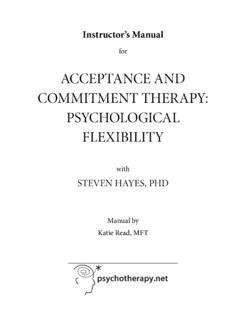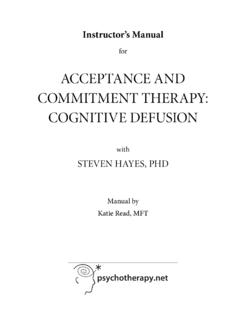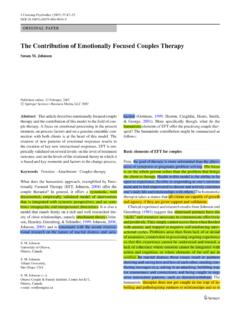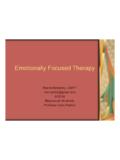Transcription of EMOTIONALLY FOCUSED THERAPY IN ACTION
1 Instructor s ManualforEMOTIONALLY FOCUSED THERAPY IN ACTION withSUE JOHNSON, EdDManual byVictor Yalom, PhD 2 EMOTIONALLY FOCUSED THERAPY IN ACTION WITH SUE JOHNSON, EdDThe Instructor s Manual accompanies the DVD EMOTIONALLY FOCUSED THERAPY in ACTION , with Sue Johnson, EdD (Institutional/Instructor s Version). Video available at 2011, , LLC. All rights reserved. Published by 150 Shoreline Highway, Building A, Suite 1 Mill Valley, CA 94941 Email: Phone: (800) 577-4762 (US & Canada)/(415) 332-3232 Teaching and Training: Instructors, training directors and facilitators using the Instructor s Manual for the DVD EMOTIONALLY FOCUSED THERAPY in ACTION , with Sue Johnson, EdD may reproduce parts of this manual in paper form for teaching and training purposes only.
2 Otherwise, the text of this publication may not be reproduced, stored in a retrieval system, or transmitted in any form or by any means electronic, mechanical, photocopying, recording or otherwise without the prior written permission of the publisher, The DVD EMOTIONALLY FOCUSED THERAPY in ACTION , with Sue Johnson, EdD (Institutional/Instructor s Version) is licensed for group training and teaching purposes. Broadcasting or transmission of this video via satellite, Internet, video conferencing, streaming, distance learning courses or other means is prohibited without the prior written permission of the , Victor, PhD Instructor s Manual EMOTIONALLY FOCUSED THERAPY in ACTION , with Sue Johnson, EdDCover design by Julie GilesArt by Michael YanezOrder Information and Continuing Education Credits.
3 For information on ordering and obtaining continuing education credits for this and other psychotherapy training videos, please visit us at or call s Manual forEMOTIONALLY FOCUSED THERAPY IN ACTION WITH SUE JOHNSON, EdDTable of ContentsTips for Making the Best Use of the DVD 4 Johnson s EFT Approach 6 Reaction Paper Guide for Classrooms and Training 9 Related Websites, Videos and Further Readings 10 Discussion Questions 12 Role-Plays 15 Session Transcript with Commentary 17 Video Credits 70 Earn Continuing Education Credits for Watching Videos 71 About the Contributors 72 More Videos 734 EMOTIONALLY FOCUSED THERAPY IN ACTION WITH SUE JOHNSON, EdDTips for Making the Best Use of the DVD1.
4 USE THE TRANSCRIPTSMake notes in the video Transcript for future reference; the next time you show the video you will have them available. Highlight or notate key moments in the video to better facilitate discussion during the video and FACILITATE DISCUSSION Pause the video at different points to elicit viewers observations and reactions to the concepts presented. The Discussion Questions provide ideas about key points that can stimulate rich discussions and learning. THE WHOLE SESSIONAs this video is quite comprehensive, you may not have time to show it in its entirety. If this is the case, you may want to show the last clip of the couple in the Case Consultation (starts at approximately 1 hour 22 minutes), and then show the entire session, conducted by Johnson.
5 Encourage viewers to voice their opinions; no THERAPY is perfect! What are viewers impressions of what works and does not work in the session? We learn as much from our mistakes as our successes; it is crucial for students and therapists to develop the ability to effectively critique this work as well as their SUGGEST READINGS TO ENRICH VIDEO MATERIALA ssign readings from Suggestions for Further Readings and Websites prior to viewing. You can also schedule the video to coincide with other course or training materials on related ASSIGN A REACTION PAPERSee suggestions in Reaction Paper section. ON VIDEOS AND THE PERSONALITY OF THE THERAPISTP sychotherapy portrayed in videos is less off-the-cuff than THERAPY in practice.
6 Therapists may feel put on the spot to offer a good demonstration, and clients can be self-conscious in front of a camera. Therapists often move more quickly than they would in everyday practice to demonstrate a particular technique. Despite these factors, therapists and clients on video can engage in a realistic session that conveys a wealth of information not contained in books or THERAPY transcripts: body language, tone of voice, facial expression, rhythm of the interaction, quality of the alliance all aspects of the therapeutic relationship that are unique to an interpersonal is an intensely private matter. Unlike the training in other professions, students and practitioners rarely have an opportunity to see their mentors at work.
7 But watching THERAPY on video is the next best more note: The personal style of therapists is often as important as their techniques and theories. Therapists are usually drawn to approaches that mesh well with their own personality. Thus, while we can certainly pick up ideas from master therapists, students and trainees must make the best use of relevant theory, technique and research that fits their own personal style and the needs of their AND CONFIDENTIALITY Because this video contains an actual THERAPY session, please take care to protect the privacy and confidentiality of the clients who have courageously shared their personal lives with FOCUSED THERAPY IN ACTION WITH SUE JOHNSON, EdDJohnson s EFT ApproachDeveloped in the early 1980s by Drs.
8 Sue Johnson and Les Greenberg, EMOTIONALLY FOCUSED THERAPY (EFT) is a short-term, structured therapeutic modality that emphasizes emotion as the key organizer of behavior patterns within intimate relationships. Using a Rogerian humanistic approach combined with systems theory and Bowlby s adult attachment theory, the EFT therapist collaborates with client couples to engage their emotions more deeply, as a gateway toward restructuring rigid negative interaction patterns that have previously made safe emotional connection difficult, if not impossible. The empathically engaged EFT therapist helps clients respond differently to their partners by offering new choices for interaction and opening up automatic emotional and behavioral responses for review and to Bowlby s attachment theory, a safe emotional connection to a few loved ones is a basic survival need hardwired in us by millions of years of evolution.
9 The fear of isolation, as well as the helplessness that comes with it, is therefore in every human heart. We all search for a relational safe haven where we can turn to for comfort and support, and a secure base from which we can venture out and explore the world. When partners experience emotional disconnection in a relationship, a predictable process of separation anxiety begins. One partner will protest, often in the form of coercive anger, followed by clinging and seeking. In secure relationships, the other partner recognizes, accepts and responds to this protest. If these behaviors provoke no response, depression and despair set in, and the protesting partner will try one of two strategies.
10 One is to shut down, avoid emotions, and seek distraction while denying his or her attachment needs. The other is to become highly anxious and to cling more, trying to coerce responsiveness. These behaviors become habitual emotional regulation strategies and default options in interactions with loved ones. The more one partner clings, the more the other avoids, creating a destructive cycle. The first step in EMOTIONALLY FOCUSED THERAPY is to assist the client couple in articulating their own version of this negative interactional cycle and externalizing it, so they can more easily identify it in the of conflict and begin to seek alternative ways of relating and responding to one an EFT session, the therapist works closely with both partners in turn to expand on their initial emotional responses during conflicts, share the emotions in a non-blaming way with their partner, and begin to connect with and articulate the underlying emotions being triggered.















